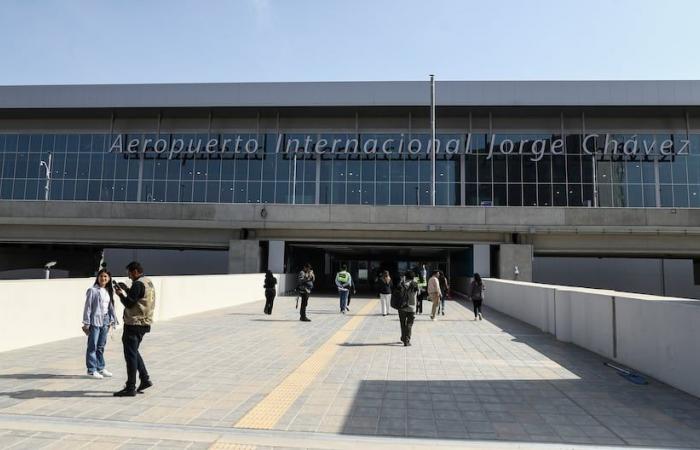
It is expected that, in its opening, the new terminal will have the capacity to receive up to 30 million passengers per year at the beginning and it is projected that it can house up to 40 million passengers at the end of 2025. Commerce visited the airport facilities this week and in this note we tell you what the entrance route will be what will be your trip, the services you will find at the airport and those that will not be.
To access the new terminal, it is entered with vehicles through the modular bridge that connects Morales Duárez Avenue – the main access road – with the new airport. Upon entering, it is conducted by a path that leads to the terminal, divided into four levels.
The first is the arrival of flights, where travelers can leave and find their relatives; The second is a commercial area, with some services such as banks, restaurants and cabins for rest. It is the entrance to the airport that will first see if it enters through the pedestrian area where the so -called free road is, where the Aero Direct Bus will arrive, which also has parking lots abroad.
On the third and fourth floor, the outputs of national and International flights are recorded, separated by blocks with letters that will allow the corresponding ‘counters’ to be easily located.
Currently, the new terminal has 90 ‘counters’ of ‘Check-in’ and by the end of the year they are 120 modules. In some of them you have the automated luggage billing system (autofacturing).
Passengers will also be able to have 39 self-service modules where they can print their boarding pass and the label for cellar luggage, in case of not having performed the ‘check-in’ at home.
After the suitcases that go to winery are labeled, these may be delivered directly to the automated modules, which connect with a 7 -kilometer system of transport strips. This system will detect even if the luggage has overweight and the corresponding collection.
As for the tomographs for security control, from Lima Airport indicate that these are advanced systems, so it will not be necessary to remove liquids or electronic equipment from the luggage. These tomographs can process between 300 to 400 hand luggage per hour. The airport will have 27 lines for hand luggage.
According to Karla Urdiales, spokeswoman for Lima Airport, this is the first South America airport that has this type of technology. The same will happen with the winery luggage, as they have four large tomographs where 2,700 luggage can pass.
At the end of this control, national passengers will cross – in the national zone – through the commercial area called “Duty Pay” (a kind of Duty Free but without the exemption of taxes being local flights) to reach their boarding rooms.
For international flights, the next step for travelers will be to go through migrations, which will have 21 modules of migratory control, in which the inspectors will verify the identity of the passengers. In addition to these ‘counters’, there will also be nine electronic doors or ‘e-gates’
Paulo Ostolaza, Zonal Chief of Callao de Migrations, commented that the Electronic doors are interconnected to migration systems, and in a first stage they will be used and aimed at Peruvians of legal age, with electronic passport, who have made a pre-registration on the website or in the mobile application of migrations 48 hours before their flight. While they are currently Peruvians with electronic passport and foreigners with a foreigner card that live in the country who can use these electronic doors, when ID 3.0 is issued, you can also use them with this document.
The pre-registration, he said, would allow to reduce migratory control with facial and biometric recognition by 20 seconds or less.
He has specified also that in this terminal there will be an area of migrations where an emergency passport can be obtained. “However, Migrations has planned to give greater operational capacity in national appointments and a deployment of different offices. The idea is to guarantee the citizen to issue his passport two business days before the flight without appointment in any of the units nationwide“, said.
However, it is recommended that users renew their passports six months before the document expiration date.
-The area, in effect, as the airline guilds indicated such as the Association of International Air Transport Companies (Aetai) is smaller than in the current terminal. In fact, from the guild they indicated that the space was 40% smaller in flight outlets and 20% in the arrivals. However, from LAP and migrations it is expected that with these modules and the pre-registration the system will be more dynamic. With electronic doors and the pre-registration, it is projected to be reduced to 20 seconds or less migratory control with facial and biometric recognition.
For arrival flights, Migrations will have 33 modules and 10 additional electronic doors.
Upon entering the national zone, an offer of ‘retail’ stores and Peruvian gastronomy will be found with four concepts. And in the international zone there will be a food Hall, with restaurants and known brands of Peruvian food.
In the tour organized by Lima Airport for the new terminal of the Jorge Chávez airport, he indicated that there will be 100 commercial spaces (between the public zone, national zone and international zone), of which 75 will be operating on June 1 and the others will open during the year.
The airport, which will have up to 30 million passengers, will have banks such as Interbank, ATMs of all entities, cabins’ Sleep N ‘Fly’ (to rest) in the public area, gastronomic courtyards, among other services. It will also be Petfriendly. Rubio details that in the national zone they have four culinary concepts of the Acurio group (Papachos, Bodegón, Broster speaks! And a Nikkei concept) and in the international zone a Food Hall with marks such as Tori, La Lucha, Burgerboy, Las Reyes, among others. In addition to brands such as Bonbonniere, Swarovski, Ilaria, Pansalaire, Delicss, Coolbox, among others.
In addition, for June 1, the VIP rooms operated by the English Airport Dimension will be operational, in addition to the protocol hall, which is the hall of authorities. And the VIP room of the Latam airline? This room is not yet ready, they comment from Lima Airport, so it will open in the coming months.
As Airport Dimension, belonging to Collinson Group, advanced to day1 a few months ago, four of the five VIP rooms of the airport will operate, according to Giorgio Benza, VP of the company for Latin America. The Salas, he said, will handle two concepts: “The Club” and “Sleep N ‘Fly” (sleeping cabins that are already used in other airports). The company has allocated US $ 20 million together for this plan.
At the opening of the airport infrastructure, there will be two rooms, Benza said: ‘The Club’, in the International Terminal, and ‘Sleep’ N Fly ‘in the public area, before the boarding rooms.
“In March 2026, the company will open the other two VIP rooms, also under the concept of ‘The Club’: one in the national terminal and another in the international zone,” said Benza.
Benza explained that the ‘The Club’ rooms will have food and cocktail services, children’s areas, spaces for free meetings and showers, among others.
In ‘Sleep’ N Fly ‘there will be up to four different types of spaces for a passenger or for a family.
Karla Urdiales, spokeswoman for Lima Airport, adds that there are 56 boarding rooms at the new terminal between the national and international zone and specifies that 65% of flights are national, while 35%, international, a proportion that remains mostly from pandmeia. In addition, remember that the airport will have modular growth.
As an additional fact, from Lima Airport they indicated that in the current terminal they have 19 sleeves, while the new infrastructure will have 46 sleeves. And, they detail, in the long term a third track could be built.
On June 1, six luggage strips will operate for the delivery of suitcases, with the capacity to process up to four simultaneous flights each, an approximate of 300 bags per hour. But towards the end of the year two more will be enabled, adding a total of eight lines to pass the luggage.
Recall that on May 15 the white march of the airport will begin, as Lima Airport said, with reduced flights, being 1% of the total airport operations, as the concessionaire indicated. This would be around 700 passengers daily, according to Juan José Salmón during an interview with RPP.





